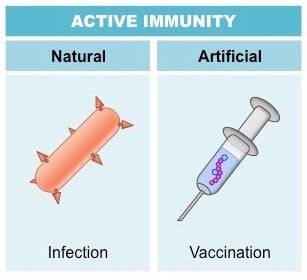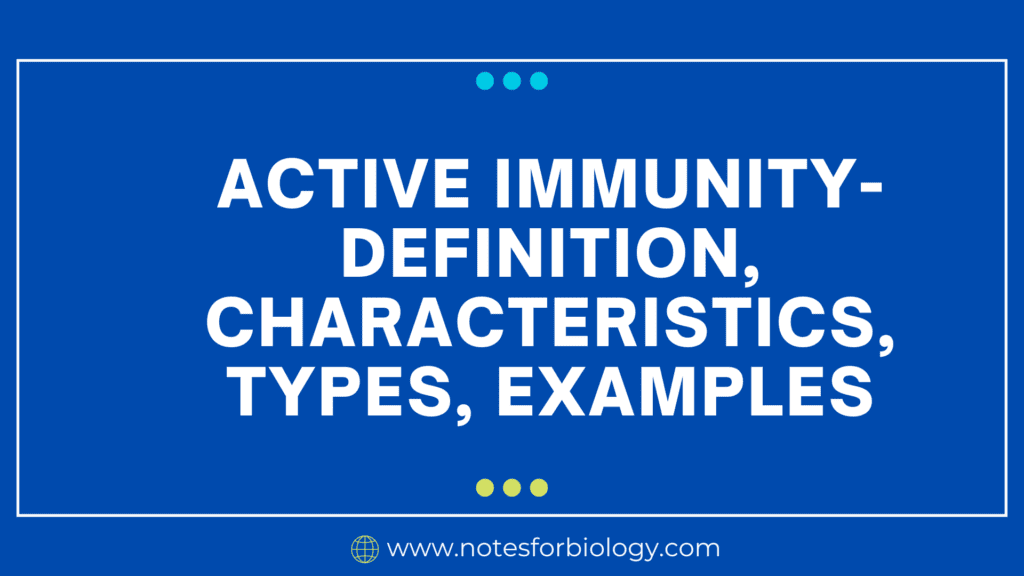Active immunity is a type of adaptive immunity in which the immune system produces antibodies and memory cells after being exposed to a disease-causing pathogen. This process can happen spontaneously when a person contracts a pathogen, or it can be induced intentionally by vaccination. It is characterized by the involvement of the immune system, which normally produces lifetime or even permanent protection against illness.
Table of Contents
What is Active Immunity?
Active immunity is the protection against diseases provided by an individual’s immune system upon exposure to an antigen. This can happen through spontaneous infection or immunization. It is distinguished by antibody production and the formation of memory cells, which give long-term protection.
Characteristics
Specificity: It is extremely specific to the infection or antigen that initiated the immune response.
Memory: The immune system preserves a memory of the infection, allowing for a faster and more efficient response on following occasions.
Long-lasting Protection: Because memory cells are created, it frequently provides long-term, even lifelong, protection.
Inducibility: It can be produced through natural infection or vaccination.
Delayed Onset: The establishment of this takes time, generally days to weeks, because the immune system must process and respond to the antigen.
Types
Natural Active Immunity
This sort of immunity is derived from natural exposure to a disease. When a person is infected with a disease-causing agent and recovers, their immune system creates antibodies and memory cells, which help protect them from subsequent infections by the same pathogen.
For example, Recovering from diseases like chickenpox or measles causes the body to establish this type of immunity against certain diseases.
Artificial Active Immunity
This type of immunity is obtained through intentional exposure to an antigen, such as vaccination. Vaccines contain viruses that have been weakened or inactivated, as well as pathogen components such as proteins, that stimulate the immune system to develop an immunological response without causing disease.
For example, Vaccination against diseases such as influenza, hepatitis B, and polio produces this type of immunity.

Examples
Natural Active Immunity
Measles: People who recover from measles usually obtain lifetime protection to the measles virus.
Chickenpox: After contracting chickenpox, the immune system remembers the virus and provides long-term immunity.
Artificial Active Immunity
Polio Vaccine: Giving the inactivated polio vaccine (IPV) induces the immune system to develop antibodies against the poliovirus.
Hepatitis B vaccination: The hepatitis B vaccination stimulates the immune system to form a defense against the hepatitis B virus, providing long-term protection.
COVID-19 Vaccines: Vaccines such as Pfizer-BioNTech and Moderna use mRNA technology to stimulate an immune response to the SARS-CoV-2 virus.
Mechanism
The mechanism of active immunity involves several steps:
Pathogens enter the body and are consumed by antigen-presenting cells (APCs), including dendritic cells and macrophages. These cells digest the pathogen and display its antigens on their surface utilizing molecules known as major histocompatibility complex (MHC) proteins.
To activate T cells, antigen-presenting cells move to lymph nodes and offer antigens to T cells. T helper cells (CD4+ T cells) identify antigens presented by MHC class II molecules, whereas cytotoxic T cells (CD8+ T cells) recognize MHC class I antigens. This identification stimulates T cells, which multiply and differentiate into effector and memory T cells.
T helper cells activate B cells, causing them to identify the same antigen. B cells that attach to the antigen are activated and begin clonal growth. They differentiate into plasma cells, which produce enormous amounts of antigen-specific antibodies, and memory B cells, which remain in the body and provide long-term immunity.
Plasma cells create antibodies, which bind to pathogens and neutralize or label them for destruction by other immune cells. Antibodies can help clear infections by preventing pathogens from infecting cells.
Memory cells are formed by both B and T cells after an immune response. These memory cells remain in the body and respond rapidly and robustly to successive exposures to the same virus. Memory B cells rapidly manufacture antibodies, whereas memory T cells coordinate the immune response to remove the pathogen.
In conclusion, Active immunity is an essential component of the immune system’s defense against infectious illnesses. Active immunity, which can be acquired through vaccination or spontaneous infection, gives the body the ability to identify and fight diseases, providing long-lasting protection and improving public health overall.
Frequently Asked Questions (FAQ)
What is the definition of Active Immunity?
Active immunity is the protection against diseases provided by an individual’s immune system upon exposure to an antigen.
In what way does immunization lead to active immunity?
Through vaccination, the body is exposed to a pathogen’s antigen or a portion of the pathogen. Without actually causing the illness, this antigen prompts the immune system to develop memory cells and antibodies. After that, the immune system “remembers” the antigen, which enables it to react to the real infection more swiftly and efficiently in the future.
Related Articles

